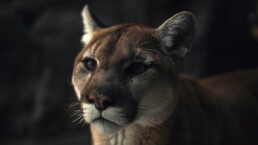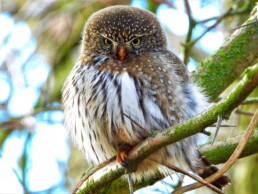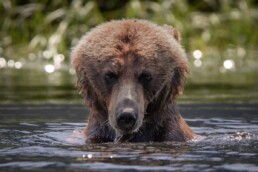Coyotes are one of the few animals that have expanded their range since European settlers arrived in North America and they’re now found in the Canadian city of Castlegar, British Columbia.
Coyotes are an intelligent, social canine known for their adaptability. They are one of the few animals whose range has expanded since European settlement, moving from their historic range in the prairie provinces into British Columbia and much of the rest of Canada. Coyotes can often be heard yipping and howling at night around Castlegar but they tend to stay out of sight.
Also known as:
- Canis latrans
- skinkuȼ (Ktunaxa)
- sk̓lep/sek̓lép; senxúxwlecw (Secwepemctsin)
- sǝnk̓lep/ snk̓lip (nsyilxcǝn)
- snklip (snslxcin)
Description:
- Medium-sized member of the dog family.
- Greyish brown to silver-grey coat.
- Thick bushy tail with black tip (held down when running).
- 1-1.3m in length
- Typically weigh between 10-15kg
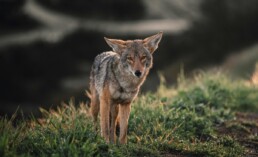
Habitat:
- Coyotes live in a wide variety of habitats including open grasslands, meadows and mixed forest.
- They are extremely adaptable and can also live in urban areas.
- Their home range is usually 10-40km2
Viewing Opportunities:
- Dawn and dusk are the best times to spot coyotes.
- Watch along roadsides and in open meadows or grassy areas where coyotes can be seen “mousing.”
- Likely locations in Castlegar include the Selkirk College grounds, kp’itl’els (Brilliant flats) and along riverbanks.
- Listen for their amazing range of vocalizations at night. You can hear coyotes at any time of the year, but they are especially vocal during the breeding season in late winter.
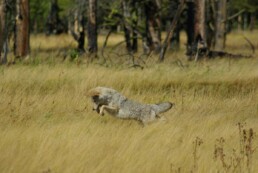
Behaviour:
- Coyotes can live as solitary individuals or in highly social family groups made up of 8-10 individuals.
- They are generally monogamous.
- Breeding season peaks in February and pups are born in April-May.
- Coyotes are most active at dawn and dusk, but can be active anytime. (They tend to be more nocturnal in urban areas.
- They are very vocal, utilizing a wide range of yips, howls, whines, growls and barks.
- They typically live 6-8 years in the wild.
Diet:
- Coyotes are generalist omnivores and eat a wide variety of foods but prefer to hunt for meat.
- A typical coyote diet includes rodents, snakes, rabbits, insects, carrion, and berries.
- They’ve also been known to consume unnatural foods such as garbage, birdseed, pet food, and pets.
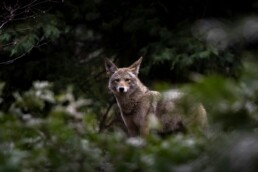
Connections:
- Coyotes provide great pest control, hunting rodents such as mice and rats near residential areas and farms.
- They are extremely adaptable and often live close to humans, which has led to a long history of conflict such as depredation of livestock and pets and consequential persecution of coyotes
- Coyotes show up as a “trickster” figures in the stories of both the Sylix and Secwepemc people, providing teachings through its adventurous, sometimes foolish mishaps.
- Attacks on people are extremely rare, but coyotes can view pets as prey. Keep dogs on leash and a careful eye on cats to prevent conflict. For more tips about avoiding coyote interactions, visit wildsafebc.com/species/coyote.
Cool Facts:
- Canis latrans translates to “barking dog”
- Coyotes can run up to 65km/hr and jump nearly 2m high.
- Two coyotes, howling in unison, can create an illusion of a dozen or more animals.
- They have extremely keen senses, especially hearing and smell.
The goal of wildlife viewing is to safely appreciate the animals in their natural surroundings with minimal impact. To achieve that, here are eight tips:
- Be respectful. Getting too close or staying too long can disrupt feeding and other important behaviours and can cause stress and unpredictable behaviour.
- Give wildlife lots of space. If an animal responds to your presence (eg: looks up, watches you, moves away), you are too close.
- Viewing roadside wildlife can have negative impacts on wildlife by disrupting feeding and leading to habituation to traffic and people. If you spot wildlife while driving, pull over only if it is safe to do so and keep your stop short and sweet.
- Keep dogs on leash and under control at all times to avoid negative encounters
- Carry bear spray and know how to use it.
- Use binoculars and zoom lenses.
- Never feed wildlife.
- Leave no trace. Pack it in, pack it out.
Get To Know The Wildlife Of Castlegar
April 3, 2025
Meet Castlegar Photographer Jamie Isaacs
March 1, 2025
Meet Castlegar Photographer Josh Fogal
March 15, 2024


